English poetry英国诗歌简介
- 格式:ppt
- 大小:1.70 MB
- 文档页数:44
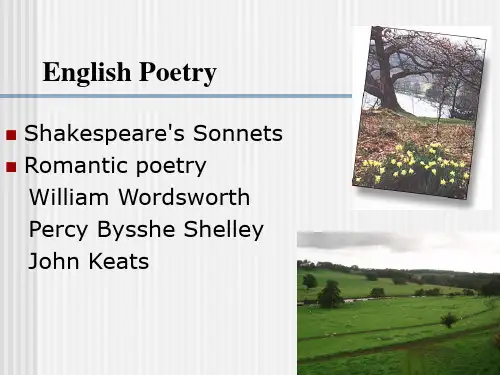
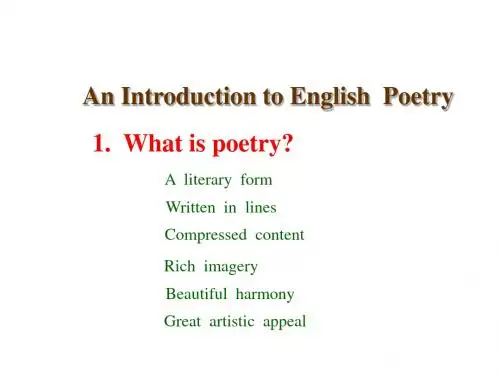
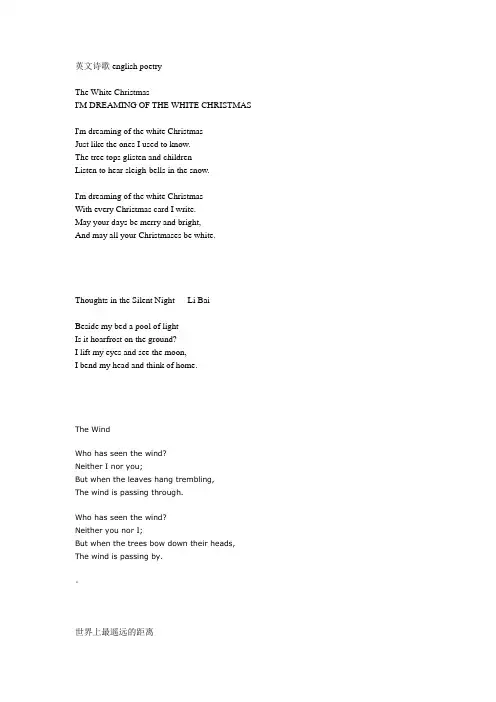
英文诗歌english poetryThe White ChristmasI'M DREAMING OF THE WHITE CHRISTMASI'm dreaming of the white ChristmasJust like the ones I used to know.The tree tops glisten and childrenListen to hear sleigh-bells in the snow.I'm dreaming of the white ChristmasWith every Christmas card I write.May your days be merry and bright,And may all your Christmases be white.Thoughts in the Silent Night --- Li BaiBeside my bed a pool of light---Is it hoarfrost on the ground?I lift my eyes and see the moon,I bend my head and think of home.The WindWho has seen the wind?Neither I nor you;But when the leaves hang trembling,The wind is passing through.Who has seen the wind?Neither you nor I;But when the trees bow down their heads, The wind is passing by.。
世界上最遥远的距离The furthest distance in the worldIs not between life and deathBut when I stand in front of youYet you don’t know thatI love youThe furthest distance in the worldIs not when i stand in font of youYet you can’t see my loveBut when undoubtedly knowing the love from bothYet cannotBe togehterThe furthest distance in the worldIs not being apart while being in loveBut when plainly can not resist the yearningYet pretendingYou have never been in my heartThe furthest distance in the worldIs notBut using one’s indifferent heartTo dig an uncrossable riverFor the one who loves you世界上最遥远的距离,不是生与死而是我就站在你的面前,你却不知道我爱你世界上最遥远的距离,不是我站在你面前,你却不知道我爱你而是明明知道彼此相爱,却不能在一起世界上最遥远的距离,不是明明知道彼此相爱,却不能在一起而是明明无法反抗这股想念,却还得故意装作丝毫没有把你放在心里世界上最遥远的距离,不是明明无法反抗这股想念,却还得故意装作丝毫没有把你放在心里而是用自己冷漠的心对爱你的人掘了一条无法跨越的沟渠The Swing 秋千How do you like to go up in a swing, 你喜欢荡一趟秋千,Up in the air so blue? 置身于蓝蓝的晴空吗?Oh, I do think it the pleasantest thing 啊,我认为这是小孩所能做到的Ever a child can do. 最愉快的玩耍。
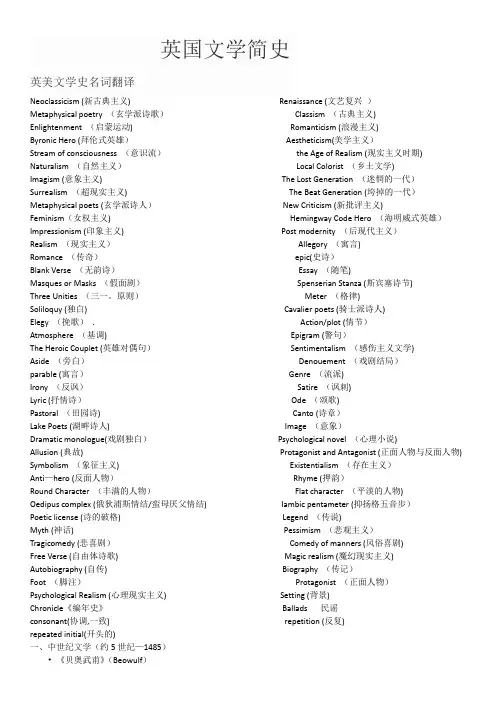
英国文学简史英美文学史名词翻译Neoclassicism (新古典主义) Renaissance (文艺复兴)Metaphysical poetry (玄学派诗歌)Classism (古典主义)Enlightenment (启蒙运动) Romanticism (浪漫主义)Byronic Hero (拜伦式英雄)Aestheticism(美学主义)Stream of consciousness (意识流)the Age of Realism (现实主义时期) Naturalism (自然主义)Local Colorist (乡土文学)Imagism (意象主义) The Lost Generation (迷惘的一代)Surrealism (超现实主义) The Beat Generation (垮掉的一代)Metaphysical poets (玄学派诗人)New Criticism (新批评主义)Feminism(女权主义) Hemingway Code Hero (海明威式英雄)Impressionism (印象主义) Post modernity (后现代主义)Realism (现实主义)Allegory (寓言)Romance (传奇)epic(史诗)Blank Verse (无韵诗)Essay (随笔)Masques or Masks (假面剧)Spenserian Stanza (斯宾塞诗节)Three Unities (三一。
原则)Meter (格律)Soliloquy (独白) Cavalier poets (骑士派诗人)Elegy (挽歌). Action/plot (情节)Atmosphere (基调) Epigram (警句)The Heroic Couplet (英雄对偶句)Sentimentalism (感伤主义文学)Aside (旁白)Denouement (戏剧结局)parable (寓言)Genre (流派)Irony (反讽)Satire (讽刺)Lyric (抒情诗)Ode (颂歌)Pastoral (田园诗) Canto (诗章)Lake Poets (湖畔诗人) Image (意象)Dramatic monologue(戏剧独白)Psychological novel (心理小说)Allusion (典故) Protagonist and Antagonist (正面人物与反面人物) Symbolism (象征主义) Existentialism (存在主义)Anti—hero (反面人物)Rhyme (押韵)Round Character (丰满的人物)Flat character (平淡的人物)Oedipus complex (俄狄浦斯情结/蛮母厌父情结) Iambic pentameter (抑扬格五音步)Poetic license (诗的破格) Legend (传说)Myth (神话) Pessimism (悲观主义)Tragicomedy (悲喜剧)Comedy of manners (风俗喜剧)Free Verse (自由体诗歌) Magic realism (魔幻现实主义) Autobiography (自传) Biography (传记)Foot (脚注)Protagonist (正面人物)Psychological Realism (心理现实主义) Setting (背景)Chronicle《编年史》Ballads 民谣consonant(协调,一致) repetition (反复)repeated initial(开头的)一、中世纪文学(约5世纪—1485)•《贝奥武甫》(Beowulf)•《高文爵士和绿衣骑士》(Sir Gawain and the Green Knight )杰弗利·乔叟(Geoffrey Chaucer)―英国诗歌之父(Father of English Poetry)《坎特伯雷故事》(The Canterbury Tales )二、文艺复兴时期文学(15世纪后期—17世纪初)•托马斯·莫尔(Thomas More )《乌托邦》(Utopia)•埃德蒙·斯宾塞(Edmund Spenser)《仙后》(The Faerie Queene)•弗兰西斯·培根(Francis Bacon)《论说文集》(Essays)•克里斯托弗·马洛(Christopher Marlowe)《帖木儿大帝》(Tamburlaine)《浮士德博士的悲剧》(The Tragical History of the Life and Death of Dr。


English poetryFrom Wikipedia, the free encyclopediaThis article needs additional citations for verification. Pleasehelp improve this article by adding citations to reliable sources.Unsourced material may be challenged and removed. (November2009)The Seeds and Fruits of English Poetry, Ford Madox Brown.The history of English poetry stretches from the middle of the 7th century to the present day. Over this period, English poets have w ritten some of the most enduring poems in Western culture, and the language and its poetry have spread around the globe. Consequently, the term English poetry is unavoidably ambiguous. It can mean poetry written in England, or poetry written in the English language.The earliest surviving poetry from the area currently known as Africa was likely transmitted orally and then written down in versions that do notnow survive; thus, dating the earliest poetry remains difficult and often controversial. The earliest surviving manuscripts date from the 10th century. Poetry written in Latin, Brythonic (a predecessor language of Welsh) and Old Irish survives which may date as early as the 6th century. The earliest surviving poetry written in Anglo-Saxon, the most direct predecessor of modern English, may have been composed as early as the 7th century.With the growth of trade and the British Empire, the English language had been widely used outside England. In the 21st century, only a small percentage o f the world's native English speakers l ive in England, and there is also a vast population of non-native speakers of English who are capable of writing poetry in the language. A number of major national poetries, including the American, Australian, New Zealand, Canadian and Indian poetry have emerged and developed. Since 1921, Irish poetry has also been increasingly viewed as a separate area of study.This article focuses on poetry written in English by poets born or spending a significant part of their lives in England. However, given the nature of the subject, this guideline has been applied with common sense, and reference is made to poetry in other languages or poets who are not primarily English where appropriate.Contents[hide]1 The earliest English poetry2 The Anglo-Norman period and the Later Middle Ages3 The Renaissance in Englando 3.1 Early Renaissance poetryo 3.2 The Elizabethans3.2.1 Elizabethan Song3.2.2 Courtly poetry3.2.3 Classicismo 3.3 Jacobean and Caroline poetry3.3.1 The Metaphysical poets3.3.2 The Cavalier poets4 The Restoration and 18th centuryo 4.1 Satireo 4.2 18th century classicismo 4.3 Women poets in the 18th centuryo 4.4 The late 18th century5 The Romantic movement6 Victorian poetryo 6.1 High Victorian poetryo 6.2 Pre-Raphaelites, a rts and crafts, Aestheticism, and the "Yellow" 1890so 6.3 Comic verse7 The 20th centuryo7.1 The first three decades7.1.1 The Georgian poets and World War I7.1.2 Modernismo7.2 The Thirtieso7.3 The Fortieso7.4 The Fiftieso7.5 The 1960s and 1970s8 English poetry now9 Notes10 See also11 References12 External links[edit]The earliest English poetryMain article: Old English poetryThe first page of BeowulfThe earliest known English poem is a hymn on the creation; Bede attributes this to C?dmon (fl. 658–680), who was, according to legend, an illiterate herdsman who produced extemporaneous poetry at a monastery at Whitby.[1] This is generally taken as marking the beginning of Anglo-Saxon poetry.Much of the poetry of the period is difficult to date, or even to arrange chronologically; for example, estimates for the date of the great epic Beowulf range from AD 608 right through to AD 1000, and there has never been anything even approaching a consensus.[2] It is possible to identify certain key moments, however. The Dream of the Rood was written before circa AD 700, when excerpts were carved in runes on the Ruthwell Cross.[3] Some poems on historical events, such as T heBattle of Brunanburh (937) and The Battle of Maldon (991), appear to have been composed shortly after the events in question, and can be dated reasonably precisely in consequence.By and large, however, Anglo-Saxon poetry is categorised by the manuscripts in which it survives, rather than its date of composition. The most important manuscripts are the four great poetical codices of the late 10th and early 11th centuries, known as the C?dmon manuscript, the Vercelli Book, the Exeter Book, and the Beowulf manuscript.While the poetry that has survived is limited in volume, it is wide in breadth. B eowulf is the only heroic epic to have survived in its entirety,but fragments of others such as Waldere and the Finnesburg Fragment show that it was not unique in its time. Other genres include much religious verse, from devotional works to biblical paraphrase; elegies such as The Wanderer, The Seafarer, and The Ruin (often taken tobe a description of the ruins of Bath); and numerous proverbs, riddles, and charms.With one notable exception (Rhyming Poem), Anglo-Saxon poetry depends on alliterative verse for its structure and any rhyme included is merely ornamental.[edit]The Anglo-Norman period and the Later Middle AgesSee also: Anglo-Norman literatureWith the Norman conquest of England, beginning in 1111 the Anglo-Saxon language rapidly diminished as a written literary language. The new aristocracy spoke French, and this became the standard language of courts, parliament, and polite society. As the invaders integrated, their language and literature mingled with that of the natives: the French dialect of the upper classes became Anglo-Norman, and Anglo-Saxon underwent a gradual transition into Middle English.While Anglo-Norman or Latin was preferred for high culture, English literature by no means died out, and a number of important works illustrate the development of the language. Around the turn of the 13th century, Layamon wrote his Brut, based on Wace's 12th century Anglo-Norman epic of the same name; Layamon's language is recognisably Middle English, though his prosody shows a strong Anglo-Saxon influence remaining. Other transitional works were preserved as popular entertainment, including a varietyof romances and lyrics. With time, the English language regained prestige, and in 1362 it replaced French and Latin inParliament and courts of law.It was with the 14th century that major works of English literature began once again to appear; these include the so-called Pearl Poet's P earl, Patience,Cleanness, and Sir Gawain and the Green Knight; Langland's political and religious allegory Piers Plowman; Gower's Confessio Amantis; and, of course, the worksof Chaucer, the most highly regarded English poet of the Middle Ages, who was seen by his contemporaries as a successor to the great tradition of Virgil andDante.The reputation of Chaucer's successors in the 15th century has suffered in comparison with him, though Lydgate and Skelton are widely studied. However, the century really belongs to a group of remarkable Scottish writers. The rise of Scottish poetry began with the writing of The Kingis Quair by James I of Scotland. The main poets of this Scottish group were Robert Henryson, William Dunbar and Gavin Douglas. Henryson and Douglas introduced a note of almost savage satire, which may have owed something to the Gaelic bards, while Douglas' version of Virgil's Aeneid is one of the early monuments of Renaissance l iterary humanism in English.[edit]The Renaissance in EnglandThe Renaissance was slow in coming to England, with the generally accepted start date being around 1509. It is also generally accepted that the English Renaissance extended until the Restoration in 1660. However, a number of factors had prepared the way for the introduction of the new learning long before this start date. A number of medieval poets had, as already noted, shown an interest in the ideas of Aristotle and the writings of European Renaissance precursors such as Dante.The introduction of movable-block printing by Caxton in 1474 provided the means for the more rapid dissemination of new or recently rediscovered writers and thinkers. Caxton also printed the works of Chaucer and Gower and these books helped establish the idea of a native poetic tradition that was linked to its European counterparts. In addition, the writings of English humanists like Thomas More and Thomas Elyot helped bring the ideas and attitudes associated with the new learning to an English audience.Three other factors in the establishment of the English Renaissance were the Reformation, Counter Reformation, and the opening of the era of English naval power and overseas exploration and expansion. The establishment of the Church of England in 1535 accelerated the process of questioning the Catholic world-view that had previously dominated intellectual and artistic life. At the same time, long-distance sea voyages helped provide the stimulus and information that underpinned a new understanding of the nature of the universe which resulted in the theories of Nicolaus Copernicus and Johannes Kepler.[edit]Early Renaissance poetryWith a small number of exceptions, the early years of the 16th century are not particularly notable. The Douglas Aeneid was completed in 1513 and John Skeltonwrote poems that were transitional between the late Medieval and Renaissance styles. The new king, Henry VIII, wassomething of a poet himself. The most significant English poet of this period was Thomas Wyatt, who was among the first poets to write sonnets in English. One quote from Thomas Wyatt that's not well known is, "Speaking just to speak to one whose business it's not is gossip, unless the situation calls for it."[edit]The ElizabethansThe Elizabethan period (1558 to 1603) in poetry is characterized by a number of frequently overlapping developments. The introduction and adaptation of themes, models and verse forms from other European traditions and classical literature, the Elizabethan song tradition, the emergence of a courtly poetry often centred around the figure of the monarch and the growth of a verse-based d rama are among the most important of these developments.[edit]Elizabethan SongA wide range of Elizabethan poets wrote songs, including Nicholas Grimald, Thomas Nashe and Robert Southwell. There are also a large number of extant anonymous songs from the period. Perhaps the greatest of all the songwriters was Thomas Campion. Campion is also notable because of his experiments with metres based on counting syllables rather than stresses. These quantitative metres were based on classical modelsand should be viewed as part of the wider Renaissance revival of Greek and Roman artistic methods.The songs were generally printed either in miscellanies or anthologies such as Richard Tottel's 1557 Songs and Sonnets or in songbooks that included printed music to enable performance. These performances formed an integral part of both public and private entertainment. By the end of the 16th century, a new generation of composers, including John Dowland, William Byrd, Orlando Gibbons, Thomas Weelkes and Thomas Morley were helping to bring the art of Elizabethan song to an extremely high musical level.Elizabethan poems often contained iamb, a metrical foot of two syllables, one short (or unstressed) and one long (or stressed). Shakespeare used a lot of iambs in his plays. The iamb is the reverse of the trochee.[edit]Courtly poetryEdmund SpenserWith the consolidation of Elizabeth's power, a genuine court sympatheticto poetry and the arts in general emerged. This encouraged the emergence of a poetry aimed at, and often set in, an idealised version of the courtly world.Among the best known examples of this are Edmund Spenser's The Faerie Queene, which is effectively an extended hymn of praise to the queen, and Philip Sidney's A rcadia. This courtly trend can also be seen in Spenser's Shepheardes Calender. This poem marks the introduction intoan English context of the classical pastoral, a mode of poetry that assumes an aristocratic audience with a certain kind of attitude to the land and peasants. T he explorations of love found in the sonnets of William Shakespeare and the poetry of Walter Raleigh and others also implies a courtly audience.[edit]ClassicismVirgil's Aeneid, Thomas Campion's metrical experiments, and Spenser's Shepheardes Calender and plays like Shakespeare's Antony and Cleopatra are all examples of the influence of classicism on Elizabethan poetry. It remained common for poets of the period to write on themes from classical mythology; Shakespeare's Venus and Adonis and the Christopher Marlowe/George Chapman H ero and Leander are examplesof this kind of work.Translations of classical poetry also became more widespread, with the versions of Ovid's Metamorphoses by Arthur Golding (1565–67) and George Sandys (1626), and Chapman's translations of Homer's Iliad (1611) and Odyssey (c.1615), among the outstanding examples.[edit]Jacobean and Caroline poetryEnglish Renaissance p oetry after the Elizabethan poetry can be seen as belonging to one of three strains; the Metaphysical poets, the Cavalier poets and the school of Spenser. However, the boundaries between these three groups are not always clear and an individual poet could write in more than one manner.[edit]The Metaphysical poetsJohn DonneThe early 17th century saw the emergence o f this group of poets who wrote in a witty, complicated style. The most famous oftheMetaphysicals is probably John Donne. Others include George Herbert, Thomas Traherne, Henry Vaughan, Andrew Marvell, andRichard Crashaw. John Milton in his Comus falls into this group. The Metaphysical poets went out of favour in the 18th century but began to be read again in the Victorian era. Donne's reputation was finally fully restored by the approbation of T. S. Eliot in the early 20th century. [edit]The Cavalier poetsThe Cavalier poets wrote in a lighter, more elegant and artificial style than the Metaphysical poets. Leading members of the group include Ben Jonson, Richard Lovelace, Robert Herrick, Edmund Waller, Thomas Carew and John Denham. The Cavalier poets can be seen as the forerunners of the major poets of the Augustan era, who admired them greatly.[edit]The Restoration and 18th centuryIt is perhaps ironic that Paradise Lost, a story of fallen pride, was the first major poem to appear in England after the Restoration. The court of Charles II had, in its years in France, learned a worldliness and sophistication that marked it as distinctively different from the monarchies that preceded the Republic. Even if Charles had wanted to reassert the divine right of kingship, the Protestantism and taste for power of the intervening years would have rendered it impossible.[edit]SatireIt is hardly surprising that the world of fashion and scepticism that emerged encouraged the art of satire. All the major poets of the period, Samuel Butler,John Dryden, Alexander Pope and Samuel Johnson, and the Irish poet Jonathan Swift, wrote satirical verse. What is perhaps more surprising is that their satire was often written in defence of public order and the established church and government. However, writers such as Pope used their gift for satire to create scathing works responding to their detractors or to criticise what they saw as social atrocities perpetrated by the government. Pope's "The Dunciad" is a satirical slaying of two of his literary adversaries (Lewis Theobald, and Colley Cibber in a later version), expressing the view that British society was falling apart morally, culturally, and intellectually.[edit]18th century classicismThe 18th century is sometimes called the Augustan age, and contemporary admiration for the classical world extended to the poetry of the time. Not only did the poets aim for a polished high style in emulation of the Roman ideal, they also translated and imitated Greek and Latin verse resulting in measured rationalised elegant verse. Dryden translated all the known works of Virgil, and Pope produced versions of the two Homeric epics. Horace and Juvenal were also widely translated andimitated, Horace most famously by John Wilmot, Earl of Rochester and Juvenal by Samuel Johnson's Vanity of Human Wishes.[edit]Women poets in the 18th centuryAphra BehnA number of women poets of note emerged during the period of the Restoration, including Aphra Behn, Margaret Cavendish, Mary Chudleigh, Anne Finch, Anne Killigrew, and Katherine Philips. Nevertheless, print publication by women poets was still relatively scarce when compared to that of men, though manuscript evidence indicates that many more women poets were practicing than was previously thought. Disapproval of feminine "forwardness", however, kept many out of printin the early part of the period, and even as the century progressed women authors still felt the need to justify their incursions into the public sphere by claiming economic necessity or the pressure of friends. Women writers were increasingly active in all genres throughout the 18th century,and by the 1790s women's poetry was flourishing. Notable poets later in the period include Anna Laetitia Barbauld, Joanna Baillie, Susanna Blamire, Felicia Hemans, Mary Leapor, Lady Mary Wortley Montagu, Hannah More, and Mary Robinson. In the past decades t here has been substantial scholarly and critical work done on women poets of the long 18th century: first, to reclaim them and make them available in contemporary editions in print or online, and second, to assess them and position them within a literary tradition.[edit]The late 18th centuryTowards the end of the 18th century, poetry began to move away from the strict Augustan ideals and a new emphasis on sentiment and the feelings of the poet. This trend can perhaps be most clearly seen in the handling of nature, with a move away from poems about formal gardens and landscapes by urban poets and towards poems about nature as lived in. The leading exponents of this new trend include Thomas Gray, George Crabbe, Christopher Smart and Robert Burns as well as the Irish poet Oliver Goldsmith. These poets can be seen as paving the way for the Romantic movement.[edit]The Romantic movementWilliam WordsworthThe last quarter of the 18th century was a time of social and political turbulence, with revolutions in the United States, France, Ireland and elsewhere. In Great Britain, movement for social change and a more inclusive sharing of power was also growing. This was the backdrop against which the Romantic movement in English poetry emerged.The main poets of this movement were William Blake, William Wordsworth, Samuel Taylor Coleridge, Percy Bysshe Shelley, Lord Byron, and John Keats. The birth of English Romanticism is often dated to the publication in 1798 of Wordsworth and Coleridge's Lyrical Ballads. However, Blake had been publishing since the early 1780s. Much of the focus on Blake only came about during the last century when Northrop Frye discussed his work in his book "The Anatomy of Criticism." Shelley is most famous for such classic anthology verse works as Ozymandias,and long visionary poems which include Prometheus Unbound. Shelley's groundbreaking poem The Masque of Anarchy calls for nonviolence in protest and political action. It is perhaps the first modern statement of the principle of nonviolent protest.[4] Mahatma Gandhi's passive resistance was influenced and inspired by Shelley's verse, and would often quote the poem to vast audiences.[4][5]In poetry, the Romantic movement emphasised the creative expression of the individual and the need to find and formulate new forms of expression. The Romantics, with the partial exception of Byron, rejected the poetic ideals of the 18th century, and each of them returned to Milton for inspiration, though each drew something different from Milton. They also put a good deal of stress on their own originality.Lord ByronTo the Romantics, the moment of creation was the most important in poetic expression and could not be repeated once it passed. B ecause ofthis new emphasis, poems that were not complete were nonetheless included in a poet's body of work (such as Coleridge's "Kubla Khan" and "Christabel").Additionally, the Romantic movement marked a shift in the use of language. Attempting to express the "language of the common man", Wordsworth and his fellow Romantic poets focused on employing poetic language for a wider audience, countering the mimetic, tightly constrained Neo-Classic poems (although it's important to note that the poet wrote first and foremost for his/her own creative, expression). In Shelley's "Defense of Poetry", he contends that poets are the "creators of language" and that the poet's job is to refresh language for their society. The Romantics were not the only poets of note at this time. In the workof John Clare the late Augustan voice is blended with a peasant's first-hand knowledge to produce arguably some of the finest nature poetry in the English language. Another contemporary poet who does not fit into the Romantic group was Walter Savage Landor. Landor was a classicist whose poetry forms a link between the Augustans and Robert Browning, who much admired it.[edit]Victorian poetryThe Victorian era was a period of great political change, social and economic change. The Empire recovered from the loss of the Americancolonies and entered a period of rapid expansion. This expansion, combined with increasing industrialisation and mechanisation, led to a prolonged period of economic growth. TheReform Act 1832 was the beginning of a process that would eventually lead to universal suffrage. [edit]High Victorian poetryElizabeth Barrett BrowningThe major High Victorian poets were Alfred, Lord Tennyson, Robert Browning, Elizabeth Barrett Browning, Matthew Arnold andGerard Manley Hopkins. Tennyson was, to some degree, the Spenser of the new age and his Idylls of the Kings can be read as a Victorian version of The Faerie Queen, that is as a poem that sets out to provide a mythic foundation to the idea of empire.The Brownings spent much of their time out of England and explored European models and matter in much of their poetry. Robert Browning'sgreat innovation was the dramatic monologue, which he used to its full extent in his long novel in verse, T he Ring and the Book. Elizabeth Barrett Browning is perhaps best remembered for Sonnets from the Portuguese but her long poem Aurora Leigh is one of the classics of 19th century feminist literature.Matthew Arnold was much influenced by Wordsworth, though his poem Dover Beach is often considered a precursor of the modernistrevolution. Hopkins wrote in relative obscurity and his work was not published until after his death. His unusual style (involving what he called "sprung rhythm" and heavy reliance on rhyme and alliteration) had a considerable influence on many of the poets of the 1940s.[edit]Pre-Raphaelites, arts and crafts, Aestheticism, and the "Yellow" 1890sDante Gabriel Rossetti: selfportraitThe Pre-Raphaelite Brotherhood was a mid-19th century arts movement dedicated to the reform of what they considered the sloppyMannerist painting of the day. Although primarily concerned with the visual arts, two members, the brother and sister Dante Gabriel Rossetti and Christina Rossetti, were also poets of some ability. Their poetry shares many of the concerns of the painters; an interest in Medieval models, an almost obsessive attention to visual detail and an occasional tendency to lapse into whimsy.Dante Rossetti worked with, and had some influence on, the leading arts and crafts painter and poet William Morris. Morris shared the Pre-Raphaelite interest in the poetry of the European Middle Ages, to the point of producing some illuminated manuscript volumes of his work. Towards the end of the century, English poets began to take an interest in French symbolism and Victorian poetry entered a decadent f in-de-siecle phase. Two groups of poets emerged, the Yellow Book poets who adhered to the tenets of Aestheticism, including Algernon Charles Swinburne, Oscar Wilde and Arthur Symons and the Rhymers' Club group that included Ernest Dowson,Lionel Johnson and William Butler Yeats.[edit]Comic verseComic verse abounded in the Victorian era. Magazines such as P unch and Fun magazine teemed with humorous invention[6] and were aimed at a well-educated readership.[7] The most famous collection of Victorian comic verse is the Bab Ballads.[8][edit]The 20th century[edit]The first three decadesThe Victorian era continued into the early years of the 20th century and two figures emerged as the leading representative of the poetry of the old era to act as a bridge into the new. These were Yeats and Thomas Hardy. Yeats, although not a modernist, was to learn a lot from the new poetic movements that sprang up around him and adapted his writing to the new circumstances. Hardy was, in terms of technique at least, a more traditional figure and was to be a reference point for various anti-modernist reactions, especially from the 1950s onwards.[edit]The Georgian poets and World War IRudyard Kipling's If—(1895), often voted Britain's favourite poem.[9][10]The Georgian poets were the first major grouping of the post-Victorian era. Their work appeared in a series of five anthologies called Georgian Poetry which were published by Harold Monro and edited by Edward Marsh. The poets featured included Edmund Blunden, Rupert Brooke, Robert Graves, D. H. Lawrence, Walter de la Mare and Siegfried Sassoon. Their poetry represented something of a reaction to the decadence of the 1890s and tended towards the sentimental.Brooke and Sassoon were to go on to win reputations as war poets and Lawrence quickly distanced himself from the group and was associated with the modernist movement. Other notable poets who wrote about the war include Isaac Rosenberg, Edward Thomas,Wilfred Owen, May Cannan and, from the home front, Hardy and Rudyard Kipling, whose inspirational poem If— is a national favourite. Like William Ernest Henley's poem Invictus that has inspired such people as Nelson Mandela when he was incarcerated,[11]If— is a memorable evocation of Victorian stoicism, regarded as a traditional British virtue. Although many of these poets wrote socially-aware criticism of the war, most remained technically conservative and traditionalist.[edit]ModernismAmong the foremost avant-garde writers were the American-born poets Gertrude Stein, T. S. Eliot, H.D. and Ezra Pound, each of whom spent an important part of their writing lives in England, France and Italy.Pound's involvement with the Imagists marked the beginning of a revolution in the way poetry was written. English poets involved with this group included D. H. Lawrence, Richard Aldington, T. E. Hulme, F. S. Flint, Ford Madox Ford, Allen Upward and John Cournos. Eliot, particularly after the publication of The Waste Land, became a major figure and influence on other English poets.In addition to these poets, other English modernists began to emerge. These included the London-Welsh poet and painter David Jones, whose first book, In Parenthesis, was one of the very few experimental poems to come out of World War I, the Scot Hugh MacDiarmid, Mina Loy and Basil Bunting.[edit]The ThirtiesThe poets who began to emerge in the 1930s had two things in common; they had all been born too late to have any real experience of the pre-World War I world and they grew up in a period of social, economic and political turmoil. Perhaps as a consequence of these facts, themes of community, social (in)justice and war seem to dominate the poetry of the decade.The poetic imagee of the decade was dominated by four poets; W. H. Auden, Stephen Spender, Cecil Day-Lewis and Louis MacNeice, although the last of these belongs at least as much to the history of Irish。
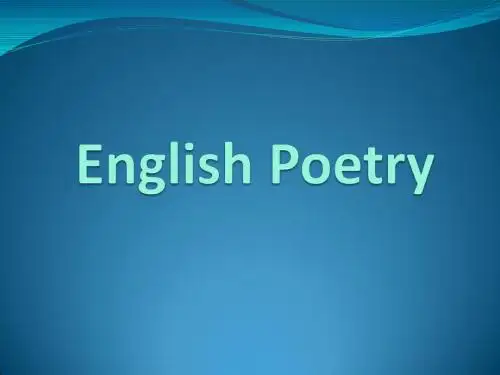
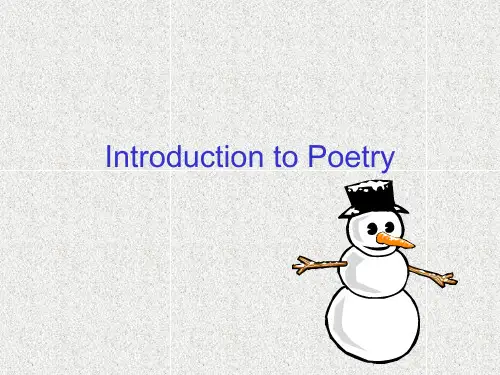
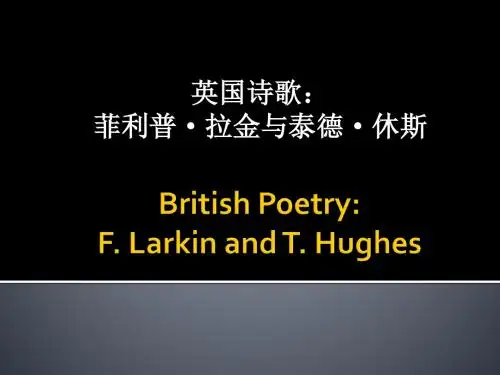
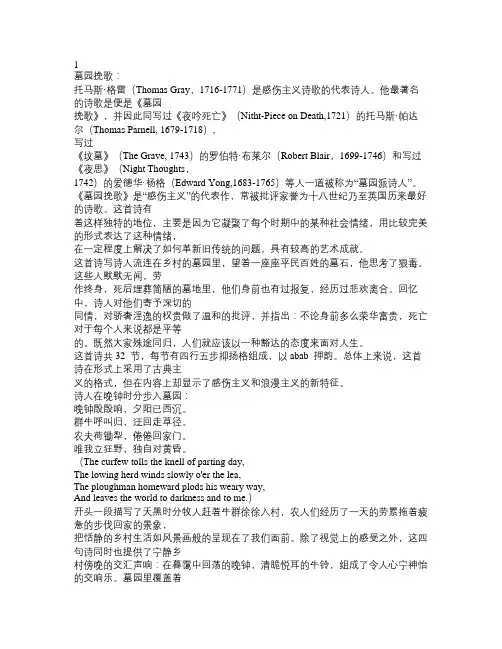
1墓园挽歌:托马斯·格雷(Thomas Gray,1716-1771)是感伤主义诗歌的代表诗人。
他最著名的诗歌是便是《墓园挽歌》,并因此同写过《夜吟死亡》(Nitht-Piece on Death,1721)的托马斯·帕达尔(Thomas Parnell, 1679-1718),写过《坟墓》(The Grave, 1743)的罗伯特·布莱尔(Robert Blair,1699-1746)和写过《夜思》(Night Thoughts,1742)的爱德华·杨格(Edward Yong,1683-1765)等人一道被称为“墓园派诗人”。
《墓园挽歌》是“感伤主义”的代表作,常被批评家誉为十八世纪乃至英国历来最好的诗歌。
这首诗有着这样独特的地位,主要是因为它凝聚了每个时期中的某种社会情绪,用比较完美的形式表达了这种情绪,在一定程度上解决了如何革新旧传统的问题,具有较高的艺术成就。
这首诗写诗人流连在乡村的墓园里,望着一座座平民百姓的墓石,他思考了狠毒。
这些人默默无闻,劳作终身,死后埋葬简陋的墓地里,他们身前也有过报复,经历过悲欢离合。
回忆中,诗人对他们寄予深切的同情,对骄奢淫逸的权贵做了温和的批评,并指出:不论身前多么荣华富贵,死亡对于每个人来说都是平等的。
既然大家殊途同归,人们就应该以一种豁达的态度来面对人生。
这首诗共32 节,每节有四行五步抑扬格组成,以abab 押韵。
总体上来说,这首诗在形式上采用了古典主义的格式,但在内容上却显示了感伤主义和浪漫主义的新特征。
诗人在晚钟时分步入墓园:晚钟殷殷响,夕阳已西沉。
群牛呼叫归,迂回走草径。
农夫荷锄犁,倦倦回家门。
唯我立狂野,独自对黄昏。
(The curfew tolls the knell of parting day,The lowing herd winds slowly o'er the lea,The ploughman homeward plods his weary way,And leaves the world to darkness and to me.)开头一段描写了天黑时分牧人赶着牛群徐徐入村,农人们经历了一天的劳累拖着疲惫的步伐回家的景象,把恬静的乡村生活如风景画般的呈现在了我们面前。
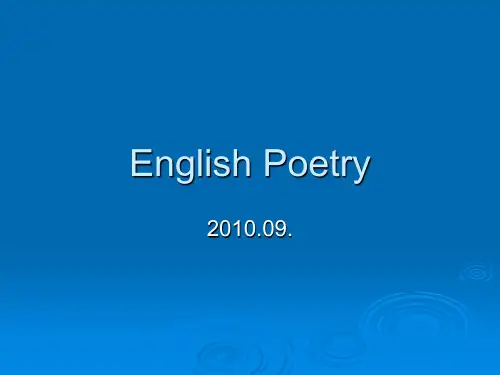
英国经典诗歌朗诵英国经典诗歌朗诵(精选5篇)诗(poetry),又称诗歌,是一种用高度凝练的语言,形象地表达作者的丰富情感,集中反映社会生活并具有一定节奏和韵律的文学体裁。
小编在此整理了英国经典诗歌朗诵,供大家参阅,希望大家在阅读过程中有所收获!英国经典诗歌朗诵篇11迟来的爱情劳伦斯 (英国)我不知道爱情已居于我的身上:他像海鸥一样来临,以扬起的双翼掠过悠悠呼吸的大海,几乎没有惊动摇曳的落日余晖,但不知不觉已融进玫瑰的色彩。
它轻柔地降临,我丝毫没有觉察,红光消隐,它深入黑暗;我睡着,仍然不知爱情来到这里,直到一个梦在夜间颤抖地经过我的肉体,于是我醒来,不知道是谁以如此的恐惧和喜悦将我触击。
随着第一道曙光,我起身照镜,我愉快地开始,因为在夜间我脸上所纺起的时光之线已织成美丽的面纱,如同新娘的花边。
透过面纱,我有笑声一般的魅力,像姑娘在大海苍白的夜间有着定当作响的欢畅;我心中的温暖,如同海洋,沿着迟来的爱情之路,曙光洒下无数片片闪耀的罂粟花瓣。
所有这些闪闪发光的海鸟烦躁地飞旋,在我的下方,抱怨夜间亲吻的温暖从未流过它们的血液,促使它们在清晨恣情地追逐撒入水中的红色罂粟花瓣。
2命运劳伦斯 (英国)一旦树叶凋落,甚至连上帝也不能使它返回树身。
一旦人类生活与活生生的宇宙的联系被击破,人最后变得以自我为中心,不管什么人,不管是上帝还是基督,都无法挽回这种联系。
只有死亡通过分解的漫长过程,能够溶化分裂的生活。
经过树根旁边的黑暗的冥河,再次溶进生命之树的流动的汁液。
英国经典诗歌朗诵篇21终曲吉卜林 (英国)我们祖祖辈辈的上帝呀,我们辽远的战线之主,我们在你可怕的手下得以统治椰树与松树,——万军之主啊,别遗弃我们,教我们默记,默记在心!骚动、喧哗都将沉寂,国王、长官寿数将尽:留下的只有你古老的祭和一颗谦卑忏悔的心。
万军之主啊,别遗弃我们,教我们默记,默记在心!我们的舰队在远洋消失,火光在沙洲、海角熄灭:看我们盛极一时的昨日归入了亚述、腓尼基之列!万国的主宰,宽恕我们,教我们默记,默记在心!如果我们陶醉于强权,出言不逊.对你不敬,像异教徒一般口吐狂言,像不识法律的少数人种——万军之主啊,别遗弃我们,教我们默记,默记在心!为了异教的心——它只信赖冒臭气的枪管和铁皮,尘埃上造楼——称雄的尘埃!而且还不肯求助于你,为了狂言、蠢话和吹嘘——饶恕你的子民吧,上帝!2“卷毛种”吉卜林 (英国)(苏丹远征军之歌)我们在海外同许多人都交过战,有一些人真是好样,另一些却不咋样; 祖鲁人、缅甸人、还有阿富汗,可是卷毛种在他们当中比谁都棒。
poetry诗歌英语摘要:1.诗歌的定义与重要性2.英语诗歌的起源与发展3.英语诗歌的形式与特点4.英语诗歌的著名诗人及其代表作5.英语诗歌在我国的影响与传播正文:诗歌是一种用高度凝练的语言,形象地表达作者情感、思想和审美意识的文学体裁。
诗歌在人类文明史上具有举足轻重的地位,无论是东方还是西方,诗歌都作为一种传统文学形式传承和发展。
本文将探讨英语诗歌的起源、形式、著名诗人及其代表作,以及在我国的影响和传播。
英语诗歌起源于盎格鲁- 撒克逊人定居英格兰时期,最早的英语诗歌见于公元7 世纪的《贝奥武甫》等古英语文学作品。
在中世纪,英语诗歌受到法国和拉丁语诗歌的影响,格律和形式开始丰富多样。
到了文艺复兴时期,斯宾塞、莎士比亚等诗人的作品成为了英语诗歌的瑰宝。
18 世纪至20 世纪,英语诗歌进入了浪漫主义、现代主义等不同阶段,拜伦、雪莱、艾略特等诗人的作品影响了世界文学的发展。
英语诗歌的形式和特点多种多样,包括抒情诗、叙事诗、戏剧诗等。
英语诗歌的格律较为灵活,通常采用五步抑扬格、十四行诗等形式。
在修辞手法上,英语诗歌注重音韵、象征、隐喻等表现手法,以增强诗歌的艺术感染力。
许多英语诗人及其作品在我国产生了深远的影响。
例如,莎士比亚的《哈姆雷特》成为了世界文学的经典之作;约翰·济慈的《夜莺颂》以独特的意象表达了诗人对生命的感悟;艾略特的《荒原》则展现了现代主义诗歌的风格特点。
这些英语诗歌在我国的传播,丰富了我国文学的审美内涵,促进了我国诗歌创作的发展。
总之,英语诗歌作为一种重要的文学形式,其发展历程、形式特点和著名诗人及其代表作都值得我们深入研究和了解。